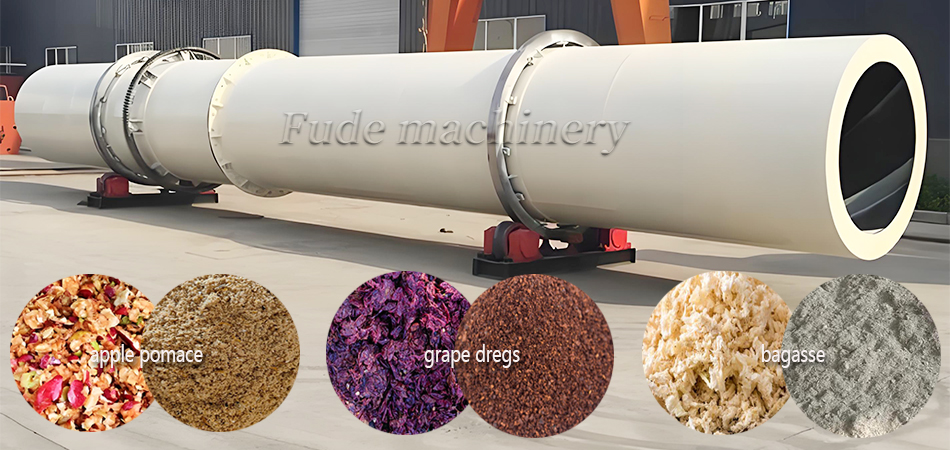Can chicken manure compost be pelletized?
292Composting and pelletizing chicken manure not only effectively solves the problem of chicken manure pollution, but also produces high-quality organic fertilizers
View detailsSearch the whole station
Pomace fertilizer production offers an effective way to recycle high-moisture organic waste, transforming it into valuable products for agricultural use. The choice of drying method plays a critical role in determining the quality of the final fertilizer. Understanding how different drying techniques influence pomace processing can help industries optimize their production procedures and enhance their products’ effectiveness.
Various high-moisture organic wastes serve as excellent raw materials for pomace fertilizer production. For instance, fruit pomace resulting from juice extraction, such as apple, grape, or citrus residues, contains nutrients beneficial for soil enrichment. Similarly, vegetable residues from food processing, brewery grains from beer production, and even coffee grounds are suitable for composting and granulation into organic fertilizers. These materials often have moisture content exceeding 90%, necessitating efficient moisture reduction processes to prepare them for fertilizer manufacturing.

Industries producing such organic waste can benefit significantly from converting pomace into fertilizer. By doing so, they not only reduce waste disposal costs but also contribute to sustainable agriculture by providing nutrient-rich compost and granulated fertilizers. The preparation of pomace for fertilizer production involves several steps, including dewatering, composting, granulating, and drying, each essential for achieving the desired quality and consistency in the final product.
The drying method employed in processing pomace directly affects the quality of the fertilizer produced. Effective dehydration is crucial since excessive moisture can hinder composting efficiency, granule formation, and the stability of the final fertilizer particles. Inadequate drying may result in microbial spoilage, reduced nutrient content, and difficulties in pomace pellet making during granulation.
Different drying techniques offer varying levels of efficiency in moisture reduction. For example, thermal drying using specialized drying equipment can lower the moisture content from over 90% to below 10%, which is ideal for pelletizing and ensuring long-term storage stability. On the other hand, improper or insufficient drying processes may lead to uneven moisture distribution, affecting the uniformity and effectiveness of the fertilizer granules.
Advanced drying machines play a pivotal role in improving pomace fertilizer production. Pomace dryers equipped with modern technology provide consistent and efficient moisture reduction, essential for high-quality fertilizer manufacturing. These machines are designed to handle the high moisture content of pomace, ensuring thorough dehydration without compromising the nutrient integrity of the organic material.
In addition to pomace dryers, equipment such as dewatering machines and composting machinery contribute to the overall efficiency of the production process. Dewatering machines reduce the initial moisture content before drying, making the drying stage more energy-efficient. Composting machines facilitate the breakdown of organic matter, enhancing the quality of the compost used in fertilizer preparation. Wet granulators or pelletizers then shape the dried compost into granules or pellets, suitable for various agricultural applications.

The integration of these specialized machines in the production system ensures that moisture reduction, composting, granulating, and drying are conducted effectively. This holistic approach to pomace fertilizer manufacturing results in high-quality granules with optimal nutrient content and physical properties, meeting the demands of modern agriculture.
The choice of drying method significantly impacts the quality of pomace fertilizer. By selecting appropriate drying techniques and utilizing advanced machinery, industries can transform high-moisture organic waste into valuable fertilizers efficiently. Investing in the right equipment, such as pomace dryers, dewatering machines, and granulators, ensures the production of high-quality fertilizer pellets that support sustainable agricultural practices. A professional drying equipment manufacturer like Fude Machinery offers the necessary expertise and technology to enhance pomace fertilizer production, contributing to both environmental sustainability and industry profitability.
Composting and pelletizing chicken manure not only effectively solves the problem of chicken manure pollution, but also produces high-quality organic fertilizers
View detailsWe offer all kinds of fish feed pellet machines including floating fish feed pellet machine and sinking feed pellet machine.
View detailsOne key component in enhancing the quality of mineral fertilizers is the fertilizer dryer.
View detailsVarious industries can benefit from using a 3T/H roll extrusion granulation line to produce NPK fertilizer pellets.
View details